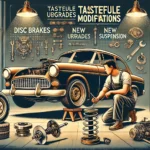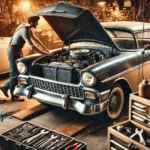Buying a classic car is an exciting experience, whether you’re fulfilling a lifelong dream or making an investment. However, purchasing a vintage vehicle requires careful research and planning to ensure you get the best deal and avoid costly mistakes. This step-by-step guide will help first-time buyers navigate the process of acquiring their first classic car with confidence.
1. Define Your Purpose for Buying a Classic Car
Before starting your search, consider why you want a classic car. This will help determine the type of vehicle that best suits your needs.
✔ For Personal Enjoyment: If you plan to drive it regularly, focus on reliable models with accessible parts.
✔ For Investment Purposes: Rarer, well-documented models tend to appreciate in value over time.
✔ For Restoration Projects: If you enjoy working on cars, a project car may be a rewarding (but time-consuming) option.
✔ For Car Shows and Events: A fully restored, high-value classic may be the best choice for showcasing.
Pro Tip: Be realistic about the time and money required for ownership, especially if restoration is needed.
2. Set a Budget (And Include Hidden Costs!)
Classic cars can vary in price from a few thousand dollars to millions, depending on the make, model, and condition. Establish a budget and factor in additional costs such as:
💰 Purchase Price – The cost of the vehicle itself.
🔧 Restoration & Repairs – Some classics require extensive work before they are roadworthy.
🛠 Maintenance & Parts – Older cars often need specialized servicing and hard-to-find parts.
🚗 Insurance – Classic car insurance differs from standard auto policies.
🏠 Storage – A safe, climate-controlled garage is ideal for preserving your investment.
Pro Tip: Set aside at least 20% of your budget for unexpected expenses after purchase.
3. Research the Best Classic Car Models for Your Needs
Some classic cars are easier to maintain and more beginner-friendly than others. Here are some popular options:
✔ Ford Mustang (1965–1970) – Affordable, easy to maintain, and widely available.
✔ Chevrolet Camaro (1967–1969) – A classic muscle car with strong aftermarket support.
✔ Volkswagen Beetle (1950s–1970s) – Simple mechanics and great for casual driving.
✔ Porsche 911 (1960s–1980s) – Appreciating in value, but maintenance can be costly.
✔ Mercedes-Benz SL (1970s–1980s) – Reliable European luxury with long-term value.
Pro Tip: Join classic car forums or clubs to get recommendations from experienced owners.
4. Find the Right Place to Buy a Classic Car
There are several ways to find classic cars for sale, each with its advantages and risks:
🏆 Classic Car Dealerships: Offer warranties and professionally restored vehicles, but prices may be higher.
🔨 Auctions (e.g., Barrett-Jackson, RM Sotheby’s): Great for rare finds, but bidding wars can drive prices up.
📢 Private Sellers: Often more affordable, but requires careful inspection and negotiation.
🌐 Online Marketplaces (eBay, Bring a Trailer, Hemmings): Wide selection, but be cautious of scams.
🚗 Car Shows and Swap Meets: Excellent for networking and finding well-maintained classics.
Pro Tip: Always verify the seller’s reputation and ask for detailed documentation.
5. Inspect the Car Thoroughly Before Buying
Classic cars require careful inspection to avoid costly surprises. Check for:
🛠 Rust & Corrosion: Rust can be a major problem, especially in hidden areas like the undercarriage and wheel wells.
⚙ Mechanical Condition: Engine, transmission, brakes, and electrical systems should be tested.
📄 Matching Numbers: Original engine and chassis numbers increase a car’s value.
📜 Documentation & History: Service records, ownership history, and any restoration work should be reviewed.
Pro Tip: Bring a mechanic or classic car expert for a pre-purchase inspection if you’re unsure.
6. Test Drive the Car
A test drive is crucial to understanding how the car performs and identifying any potential issues. Pay attention to:
✔ Engine Performance: Does it start smoothly and run without unusual noises?
✔ Braking & Handling: Are the brakes responsive, and does the steering feel stable?
✔ Transmission Shifts: Are the gear changes smooth, or do they slip?
✔ Comfort & Interior: Are the seats, dashboard, and controls in good condition?
Pro Tip: Drive the car for at least 15–20 minutes to test it in different conditions.
7. Negotiate the Price
Once you’ve found the right classic car, be prepared to negotiate. Here’s how to get the best deal:
📉 Research Market Value: Use resources like Hagerty’s Valuation Tool or Classic.com to compare prices.
🔍 Highlight Issues: If you find flaws during the inspection, use them as leverage to lower the price.
💵 Be Ready to Walk Away: If the seller isn’t flexible and the deal doesn’t feel right, don’t hesitate to look elsewhere.
Pro Tip: Cash offers or pre-approved financing can give you more negotiating power.
8. Finalize the Purchase and Paperwork
Before handing over the money, ensure all necessary documents are in order:
📜 Title & Ownership Papers – Confirm the seller legally owns the car.
📝 Bill of Sale – A written agreement outlining the terms of the sale.
📊 Maintenance Records – Valuable for future repairs and resale.
🔐 VIN Check & History Report – Use Carfax or VINCheck to ensure the car hasn’t been stolen or severely damaged.
Pro Tip: If buying internationally, check import regulations and taxes for your country.
9. Secure Classic Car Insurance
Classic car insurance differs from regular auto insurance. Look for policies that offer:
✔ Agreed Value Coverage – Ensures you receive the full appraised value in case of loss.
✔ Limited Mileage Discounts – Many insurers offer lower rates if you don’t drive the car daily.
✔ Restoration Coverage – Covers repairs and restoration costs.
Pro Tip: Compare insurance quotes from providers like Hagerty, Grundy, and American Collectors Insurance.
10. Enjoy and Maintain Your Classic Car
Congratulations! You’re now the proud owner of a classic car. To keep it in top condition:
🔧 Regular Maintenance: Schedule routine inspections and oil changes.
🏠 Proper Storage: Keep the car in a dry, climate-controlled garage to prevent rust.
🚗 Drive It Regularly: Running the engine and taking short drives will keep it in good working order.
📅 Join Car Events: Attend rallies, shows, and club gatherings to connect with other enthusiasts.
Pro Tip: Keep detailed records of maintenance and restoration work—it will help retain your car’s value.
Final Thoughts
Buying a classic car is an exciting journey that requires careful planning and research. By following these steps, you’ll avoid common pitfalls and make an informed purchase that you’ll enjoy for years to come.








